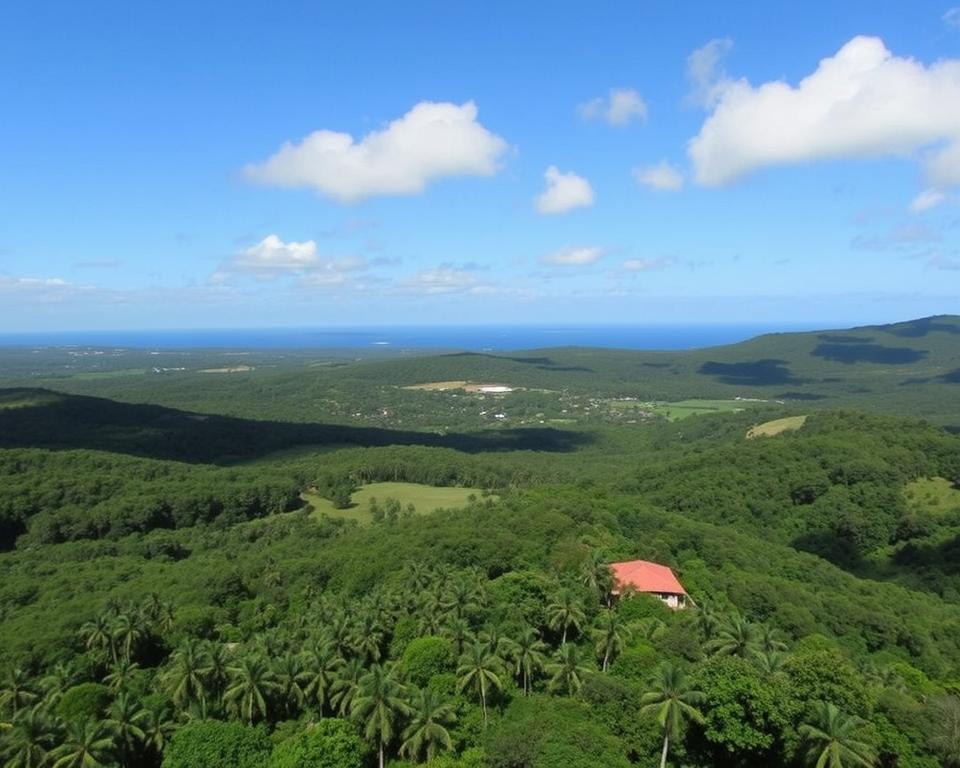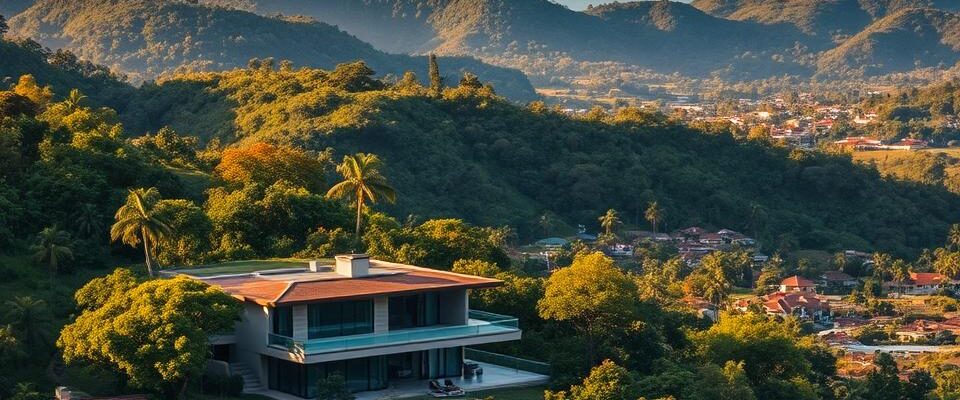Real estate trends and forecasts in Costa Rica: Our Expertise
At Gap Real Estate (Grupo Gap LLC SRL), we’ve spent over two decades simplifying the process of buying, selling, or investing in Costa Rica. As we head into 2025, Costa Rica’s property market is gaining significant momentum.
Recent reports indicate that real estate prices in key coastal regions are expected to rise by up to 8 percent this year. This growth is driven by increasing demand from international buyers, the global shift toward remote work, and the country’s strong tourism sector.
With our expertise, we’ll provide insights into the factors driving market growth and regional variations, helping potential investors and homebuyers make informed decisions.
The Current State of Costa Rica’s Real Estate Market
As we look at the current state of Costa Rica’s real estate market, several trends emerge. Costa Rica’s property sector has demonstrated remarkable resilience over the past decade, attracting significant foreign investment.
Market Performance in 2024-2025
The Costa Rican real estate market has shown impressive resilience and stability throughout 2024, with property values increasing by approximately 7.8% across the country. Coastal regions like Guanacaste and the Southern Zone have experienced the most significant growth, with some areas seeing appreciation rates of 10-12% year-over-year.
Key Factors Driving Market Growth
Several key factors are driving this market growth, including Costa Rica’s political stability, strong tourism recovery post-pandemic, and increasing interest from international investors. The shift to remote work has also transformed what was once seasonal interest into year-round demand, particularly for properties with reliable internet connectivity and natural surroundings.
Real Estate Trends and Forecasts in Costa Rica
As we look to the future, Costa Rica’s real estate market is poised for significant growth. The country’s unique blend of natural beauty, biodiversity, and lifestyle benefits continues to attract a diverse range of buyers and investors.
Price Appreciation Projections
Price appreciation in Costa Rica’s real estate market is expected to continue, with projections indicating a 6-8% annual growth rate through 2025-2026. Regional variations are significant, with Guanacaste and the Southern Zone leading at 8-12% growth, while the Central Valley maintains a stable 4-6% increase.
- Premium coastal and mountain-view properties are expected to experience higher growth rates.
- Regional variations will continue to influence appreciation rates.
Changing Buyer Demographics
The buyer demographic in Costa Rica is evolving, with a notable increase in younger investors (35-50 age range) seeking lifestyle changes and investment opportunities. Remote workers and digital nomads have emerged as a significant new buyer segment, looking for properties that blend work functionality with Costa Rica’s natural beauty.
- Eco-conscious investors are seeking sustainable properties and developments.
- The luxury market segment is expanding, with high-net-worth individuals seeking exclusive properties.
Regional Market Analysis
Costa Rica’s diverse regions offer a wide range of real estate opportunities, each with its unique characteristics and growth potential. As we examine the different areas, it becomes clear that understanding these regional dynamics is key to making informed investment decisions.
Guanacaste: The Northern Pacific Coast
Guanacaste continues to be a hotspot for luxury beachfront properties, with areas like Tamarindo and Nosara commanding high prices and showing significant appreciation.

Central Valley: Urban Opportunities
The Central Valley, including cities like San José and Escazú, offers a mix of urban conveniences and natural beauty, making it attractive to expatriates and locals alike.

Southern Zone: Emerging Hotspot
The Southern Zone, with towns like Dominical and Uvita, is emerging as a prime location for eco-conscious investors, driven by its natural beauty and growing infrastructure.

Caribbean Coast: Untapped Potential
The Caribbean Coast, including areas like Puerto Viejo, remains one of Costa Rica’s most affordable coastal regions, offering significant value and growth potential for investors.
By understanding the unique characteristics and growth potential of each region, investors can make informed decisions about where to invest in Costa Rica’s diverse real estate market.
Property Type Investment Analysis
The Costa Rican property market is characterized by a range of investment options, from luxury homes to eco-friendly developments. As investors, we can capitalize on the country’s growing demand for diverse real estate investments.
Luxury Residential Properties
Luxury homes in Costa Rica, particularly those with ocean views or beachfront access, continue to appreciate in value due to their limited availability and high demand. These premium properties feature modern amenities and sustainable design elements, appealing to affluent buyers.

Vacation Rentals and Tourism-Driven Investments
Vacation rentals in popular tourist destinations like Tamarindo and Manuel Antonio offer substantial returns, with occupancy rates of 70% or higher and rental yields between 6-10% annually. Costa Rica’s thriving tourism industry drives the demand for vacation rentals.

Eco-Friendly and Sustainable Developments
Eco-friendly and sustainable real estate projects are gaining popularity, driven by buyers who prioritize environmental stewardship. These developments offer modern amenities while aligning with Costa Rica’s conservation values.

Land Investment Opportunities
Land investment opportunities remain abundant in emerging regions, offering potential for long-term appreciation as development expands. Investors can capitalize on the growing demand for land in areas with high growth potential.

Market Dynamics Shaping Costa Rica’s Real Estate
Various factors, including the remote work revolution and tourism recovery are reshaping the dynamics of Costa Rica’s real estate market.
Remote Work Revolution
The shift towards remote work has transformed Costa Rica’s real estate market, creating year-round demand for properties that offer reliable internet and beautiful surroundings. Digital nomads and remote professionals seek homes with fiber-optic internet, dedicated office spaces, and natural surroundings that provide a work-life balance.
This trend has expanded the market beyond traditional expatriate areas, with remote workers considering emerging regions that offer connectivity, natural beauty, and value.
Tourism Recovery and Growth
Costa Rica’s tourism industry has rebounded strongly, exceeding pre-pandemic visitor numbers and directly impacting the vacation rental market and property values in tourist-centric locations.
The relationship between tourism and real estate continues to strengthen, with many visitors becoming property buyers after experiencing Costa Rica’s natural beauty and lifestyle benefits.
Foreign Investment Landscape
The foreign investment landscape in Costa Rica is thriving, with a diverse range of international buyers drawn to its natural beauty and economic stability. Foreign buyers now account for nearly 40% of all transactions, with most interest coming from the U.S., Canada, and Europe.
Origins and Motivations of Buyers
North American buyers lead the market, followed by Europeans and an increasing number of investors from Latin American countries. The primary motivations for foreign buyers include lifestyle benefits, retirement planning, investment diversification, and the desire for a safe haven in a politically stable country with strong environmental values.
Incentives and Visa Programs for Investment
The government’s investment incentives, including the popular digital nomad visa program, retirement benefits, and relatively straightforward property ownership laws for foreigners, continue to attract international buyers. Costa Rica allows non-citizens to own property with the same rights as locals, making it an accessible market for international investors.
Price Trends and ROI Expectations
Understanding price trends and ROI expectations is crucial for investors looking to capitalize on Costa Rica’s real estate market. As we delve into the specifics, it becomes clear that various factors influence the return on investment in this vibrant market.
Appreciation Rates by Region
Appreciation rates in Costa Rica vary significantly by region. Coastal properties, particularly in Guanacaste and the Southern Zone, are experiencing the strongest appreciation rates, ranging from 8-12% annually. In contrast, the Central Valley maintains steady growth of 4-6%. Beachfront properties and ocean-view homes are witnessing the most significant appreciation due to their limited availability and high demand.
Rental Yield Projections
Rental yields in Costa Rica remain attractive, typically ranging between 5-8% depending on the property’s location, amenities, and proximity to key tourist attractions. Vacation rentals in prime tourist areas can achieve net yields of 6-10% annually when professionally managed. Long-term rentals offer more stable but generally lower returns of 4-6%, making them attractive to investors seeking consistent income.
Investors can expect particularly strong rental income in regions with high tourism traffic and well-developed infrastructure. Properties in emerging areas with improving infrastructure often offer the best combination of affordable entry prices, strong appreciation potential, and competitive rental yields.
Infrastructure Developments Impacting Property Values
As we look to the future, it’s clear that infrastructure developments will play a crucial role in shaping Costa Rica’s real estate market. The country’s ongoing investments in transportation, utilities, and internet connectivity are transforming the landscape for property investors.
Transportation Improvements
Major transportation improvements are underway, including the expansion and improvement of the national highway system. The completion of key routes connecting the Central Valley to coastal areas has reduced travel times and increased property values along these corridors. Airport expansions, such as the Daniel Oduber International Airport in Liberia, have enhanced accessibility for international visitors and investors, directly boosting property values in surrounding areas.
Utilities and Internet Connectivity
Utilities infrastructure is also expanding, with improvements in water management systems and electrical grids supporting new development areas. This makes previously challenging locations viable for quality construction. Internet connectivity has become a critical factor in property valuation, with the expansion of fiber optic networks throughout the country enabling remote work and enhancing property appeal for international buyers.
These infrastructure improvements are opening up new investment opportunities in previously overlooked regions, creating potential for early investors to benefit from significant appreciation as development follows infrastructure.
Legal Considerations for Real Estate Investors
When investing in Costa Rica’s real estate, understanding the legal landscape is crucial for a secure transaction. We must consider various legal aspects to ensure compliance with local laws and regulations.
Property Ownership Structures
Property ownership in Costa Rica can be structured through direct personal ownership or via a Costa Rican corporation (Sociedad Anónima or S.A.). The corporate structure offers advantages such as liability protection and simplified inheritance procedures.
- Direct personal ownership is straightforward but may expose individuals to personal liability.
- Corporate ownership provides liability protection and can simplify inheritance.
- Recent transparency laws have impacted the privacy benefits of corporate ownership.
Tax Implications
Understanding the tax implications is vital for real estate investors in Costa Rica. Property owners must comply with various taxes, including property tax and potential capital gains tax.
- Annual property tax is approximately 0.25% of the registered property value.
- Municipal tax is also around 0.25%.
- Capital gains tax on profits from property sales is 15% for properties sold after July 1, 2019.
Working with experienced real estate agents and legal professionals is crucial for navigating these complexities and ensuring a secure investment. Due diligence, including thorough title searches and verification of property boundaries, is critical in Costa Rica’s real estate market.
Environmental Factors and Sustainable Development
As we explore the future of Costa Rica’s real estate market, it’s essential to consider the environmental factors shaping the industry. Costa Rica’s commitment to environmental protection has a significant impact on its real estate development landscape.
Climate Resilience in Property Development
Climate resilience has become a critical factor in property development, with buyers and developers considering the potential impacts of extreme weather events, sea-level rise, and changing precipitation patterns. Modern developments are incorporating sustainable design elements, including solar power, water collection systems, and natural ventilation.
Conservation Zones and Building Restrictions
Conservation zones and building restrictions vary significantly by region, with coastal properties subject to maritime zone regulations. Environmental impact studies are required for many development projects, particularly those near protected areas or involving significant land alteration. Understanding these environmental factors is essential for investors to avoid significant penalties and ensure compliance with regulations.
Financing Options for International Buyers
Financing options for international buyers in Costa Rica’s real estate market are expanding, offering competitive mortgage products. This development makes it easier for international investors to enter the market.
Local Banking Solutions
Several local banks in Costa Rica offer mortgage options to non-residents, although the terms can vary. Typically, a larger down payment is required, often around 30 to 50 percent.
International Financing Alternatives
International financing alternatives include home equity loans or lines of credit on existing properties in the buyer’s home country. These options can offer more favorable terms and simpler qualification processes.
Key financing options for international buyers include:
- Local banking solutions with 50-70% loan-to-value ratios and terms of 15-30 years.
- International financing alternatives, such as home equity loans.
- Seller financing is beneficial for higher-value properties.
- Cash purchases remain prevalent in the Costa Rican real estate market.
Market Challenges and Risk Mitigation
The Costa Rican real estate market, while presenting numerous opportunities, also comes with its own set of challenges that investors must navigate. Understanding these challenges is crucial for making informed investment decisions.
Potential Market Vulnerabilities
Potential market vulnerabilities include currency fluctuations that affect foreign buyers and the possibility of oversupply in some high-development regions. Climate-related risks are also a concern, particularly for properties located on the coast.
Due Diligence Best Practices
To mitigate these risks, investors should adopt best practices in due diligence. This includes comprehensive title searches, professional property inspections, and verification of all permits and approvals. Working with reputable local professionals is also essential.
Long-Term Outlook: Beyond 2025
As we look beyond 2025, Costa Rica’s real estate market is poised for continued growth. New infrastructure developments, including airports, highways, and expanded fiber optic networks, will improve accessibility and increase property values in currently underdeveloped areas.
Emerging Regions to Watch
Emerging regions to watch include the northern Caribbean coast around Tortuguero and Barra del Colorado, the southern Nicoya Peninsula, and inland areas with cooler climates and agricultural potential. These areas are expected to become more desirable as climate patterns shift and infrastructure improves.
Projected Market Evolution
The projected market evolution includes increased emphasis on sustainable and eco-friendly development. Buyers are willing to pay premiums for properties incorporating renewable energy, water conservation, and environmentally sensitive design. The expansion of digital infrastructure will make remote work viable in rural regions, potentially redistributing demand beyond current hotspots.
Gap Real Estate: Your Trusted Partner in Costa Rica
With a rich history of coast-to-coast expertise, Gap Real Estate stands as a trusted name in Costa Rica’s property landscape. Our extensive knowledge spans every aspect of Costa Rica’s diverse real estate markets.
Our Coast-to-Coast Expertise
At Gap Real Estate (Grupo Gap LLC SRL), we bring over two decades of comprehensive experience across Costa Rica’s diverse real estate markets, from the Pacific beaches of Guanacaste to the Caribbean coast and everything in between. Our team’s extensive knowledge includes regional market trends, legal requirements, and environmental regulations.
Comprehensive Services for Buyers and Investors
We provide tailored services for both buyers and investors, including property sourcing, due diligence coordination, negotiation support, and post-purchase property management solutions. Our multilingual team ensures clear, transparent communication throughout every step of the transaction process.
Why Choose Gap Real Estate for Your Costa Rican Investment
At Gap Real Estate, we pride ourselves on providing unparalleled expertise in Costa Rica’s real estate market. Our extensive experience and local knowledge make us the ideal partner for your investment journey.
Deep Local Knowledge and Market Insights
Our deep understanding of Costa Rica’s diverse regions and micromarkets allows us to provide valuable insights that can’t be found in market reports. With over 20 years of hands-on experience, we guide clients toward informed decisions, taking into account seasonal variations in rental demand and upcoming infrastructure projects.
- We understand the nuances of each region, from Guanacaste to the Central Valley.
- Our strong relationships with local municipalities and developers give us access to off-market opportunities.
End-to-End Support Throughout Your Journey
We offer comprehensive services, including property management, rental program coordination, and renovation oversight, ensuring a seamless experience for our clients. From initial property searches to closing and beyond, we handle the complexities so you don’t have to.
- Our team provides genuine end-to-end support throughout your investment journey.
- We pride ourselves on being true partners in your Costa Rican investment journey, built on trust and transparency.
Conclusion
As we look to the future, Costa Rica’s real estate market is poised for continued growth. The trends we’ve analyzed indicate a promising outlook, with strong appreciation potential and attractive rental yields in key regions. Understanding regional nuances, property types, and legal considerations is crucial for informed investment decisions. At Gap Real Estate, our 20+ years of coast-to-coast expertise position us to guide you through every aspect of your Costa Rican real estate journey. Whether you’re seeking a vacation home or ian nvestment opportunity, we’re committed to providing insights, support, and personalized service. Contact us today to begin your journey into Costa Rica’s dynamic real estate market with confidence.




